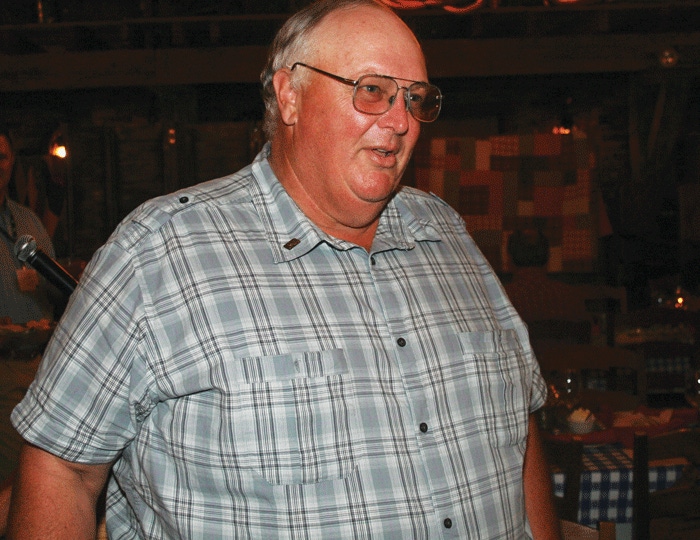August 9, 2011

Picking cotton and planting cotton on the same day isn’t something Cape Charles, Va. grower Dave Long recommends.
But when Mother Nature forced him to do so, the results were much better than he ever imagined.
Long grows about a thousand aces of cotton on Virginia’s Eastern Shore Peninsula, near Cape Charles, Va.
His farm is located about two miles from the Atlantic Ocean on the east and two miles from the Chesapeake Bay to the west. To say that combination provides some interesting weather phenomena is a classic understatement.
“We are blanketed by water and our ground stays cool in the spring and proximity to the two large bodies of water keeps it from frosting early in the fall. Our land must be conventionally-tilled, because our soil is too cool for strip-tilling or no-tilling. Long says.
In 2010 dry weather pushed his cotton planting date back by several days. Typically this isn’t a big problem because of the frost-proofing characteristics of his unique farming location, which provides some flexibility at fall harvest time, compared to other areas of central and northern Virginia.
Unfortunately, the fall of 2010 was anything but typical on Virginia’s Eastern Shore.
“We planted our cotton a little late, which pushed maturity back some, and subsequently delayed our harvest. Then we had the wettest November on record, with 25 inches of rain,” he recalls.
“After all the rain, we couldn’t get in the field to pick our cotton until December or January.
“We kept some fields of cotton in the ground 12 months. In a few fields of cotton we planted last May, we picked and planted cotton in some of those fields this May,” he says.
“I got my cotton picker stuck in the field on Jan. 10 of this year, and I couldn’t get it out. I couldn’t even walk through the field to the picker until the end of March,” he adds.
He says when he finally got to his picker, he got it stuck again and that was the final straw.
“I knew we would just tear the field apart trying to do anything at that time, so we decided to wait. The ground finally dried up enough to run the picker in early May, and we literally picked and planted in one field on the same day,” he says.
Waiting actually helped
Long says the 2010 cotton he picked this May was 50 percent better than the cotton he tried to pick in December and January, after the record flooding.
He doesn’t speculate on how good or how bad his total acreage of cotton yielded, but he does stress that from one particular 25 acre field of cotton, which he planted May of 2010 and picked May of 2011, he sold his late crop for $1.02 a pound, making it the best cotton he’s ever picked.
Long admits his cotton is a little different because of his proximity to large bodies of water. His 12-month cotton was smaller fields, better shielded from winter weather, and it wasn’t defoliated. It sat in the field, and didn’t break down. Yield was nearly 1,000 pounds per acre and quality was good, according to the Virginia grower.
He says not defoliating the cotton probably helped. The leaves, he believes, helped it through the winter. “We didn’t have any Northeasters come through, so there wasn’t any really bad weather over winter.”
The year before, he had cotton he contends would have made 1,500 pounds per acre, before the northeaster hit. “These storms often just sit offshore and blast us with 40-50 mile an hour wind for days at a time.”
“We lost 30 percent of our cotton after that storm, which produced a constant wind of 40 miles per hour, with gusts even higher for 60 straight hours,” Long says.
Determined to not get into a situation in which he has to leave cotton exposed to Atlantic storms, Long planted cotton this year in conditions he says were too dry. “We were getting large clumps of soil and we couldn’t break them up properly, but we got the cotton planted,” he adds.
The early-planted cotton had a good stand, he says. Some of the late planted cotton, on the other hand, probably had an 80 percent stand at best.
In the last two weeks of June this year, the same land that got 25 inches of rain last November was inundated with 12 or more inches of rainfall.
“We weren’t able to get on the land to cultivate, which requires us to do some different things than most cotton growers do,” he says.
For one thing, he says, they will apply the first application of Pix in a tank-mix with a second application of glyphosate. And, he adds, he had to apply the chemicals with a helicopter.
“Using a helicopter is more costly, and we feel like we get 60-70 percent as good a job as applying it with a ground applicator. But, when it’s time to apply Pix, its not a good thing to wait the 10 days or so we would have had to waited to use a ground sprayer,” he adds.
Weather challenges aren’t the only holdbacks to growing cotton on Eastern Shore of Virginia. For one thing, the nearest cotton gin is in Suffolk, requiring a tedious, and expensive, trip across narrow, heavily traveled bridges and/or tunnels.
In addition to cotton, Long plants more than 200 acres of Irish potatoes, and about 400 acres of grain crops. Leaving any of those crops in the field 12 months likely wouldn’t have had nearly as favorable results as cotton, he says.
About the Author(s)
You May Also Like






